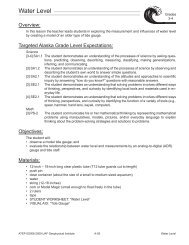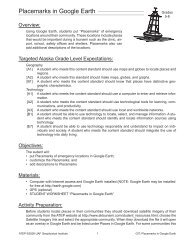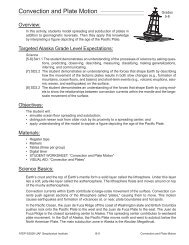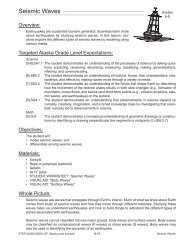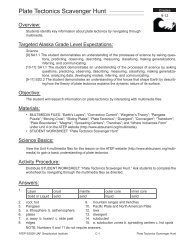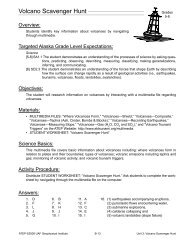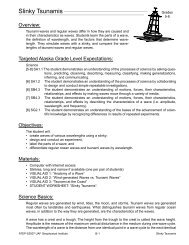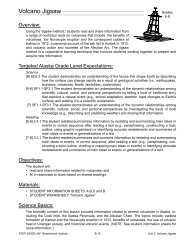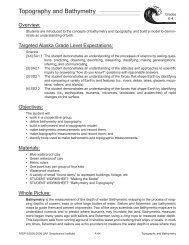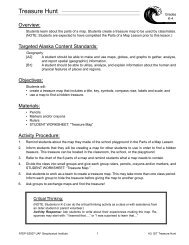Volcanoes and Tsunamis
Volcanoes and Tsunamis
Volcanoes and Tsunamis
Create successful ePaper yourself
Turn your PDF publications into a flip-book with our unique Google optimized e-Paper software.
<strong>Volcanoes</strong> <strong>and</strong> <strong>Tsunamis</strong><br />
Overview:<br />
In this lesson, students learn how volcanoes are formed <strong>and</strong> observe a model volcano eruption.<br />
Targeted Alaska Grade Level Expectations:<br />
Grades<br />
K-4<br />
Science<br />
[3-4] SA1.1 The student demonstrates an underst<strong>and</strong>ing of the processes of science by asking questions,<br />
predicting, observing, describing, measuring, classifying, making generalizations,<br />
inferring, <strong>and</strong> communicating.<br />
[4] SD2.2 The student demonstrates an underst<strong>and</strong>ing of the forces that shape Earth by identifying<br />
causes (i.e., earthquakes, tsunamis, volcanoes, l<strong>and</strong>slides, <strong>and</strong> avalanches) of rapid<br />
changes on the surface.<br />
Objectives:<br />
The student will:<br />
• identify layers of Earth;<br />
• distinguish magma from lava;<br />
• explain how volcanoes are formed; <strong>and</strong><br />
• illustrate a volcano triggering a tsunami.<br />
Materials:<br />
• Globe<br />
• Chocolate-covered cherries or soft-boiled egg<br />
• Baking Soda (½ tablespoon)<br />
• Vinegar (¼ cup)<br />
• Red food coloring<br />
• Dish soap (½ tablespoon clear, yellow or orange)<br />
• Erupting Cross Section Volcano Model by Learning Resources ®<br />
• MULTIMEDIA FILES: “Earth’s Layers,” “Magma,” “Where <strong>Volcanoes</strong> Form,” <strong>and</strong> “Volcano Tsunami<br />
Triggers” on the ATEP Website http://www.aktsunami.org/multimedia<br />
• VISUAL AID: “Volcano Box”<br />
• STUDENT WORKSHEET: “<strong>Volcanoes</strong> <strong>and</strong> <strong>Tsunamis</strong>”<br />
Science Basics:<br />
The multimedia files present concepts used to explain the formation of volcanoes <strong>and</strong> volcanic activity<br />
known to produce tsunamis. <strong>Volcanoes</strong> are vents in Earth’s crust through which lava, gas <strong>and</strong> ash<br />
are forced out.<br />
Earth’s Layers<br />
Earth is made of four layers. The outermost layer is the crust; of all the layers, this is the thinnest.<br />
Below the crust is the mantle; this layer is solid, but high temperatures soften it <strong>and</strong> cause it to change<br />
shape. Below the mantle is the outer core, which is so hot it acts like a liquid. Finally, the hot inner<br />
core is squeezed into a solid ball by outside pressure.<br />
ATEP ©2008 UAF Geophysical Institute A-1 Unit 3: <strong>Volcanoes</strong> <strong>and</strong> <strong>Tsunamis</strong>
Magma<br />
Magma is hot, molten rock that forms deep inside Earth’s mantle. When magma reaches Earth’s surface,<br />
it becomes lava.<br />
Where <strong>Volcanoes</strong> Form<br />
Most volcanoes form over subduction zones <strong>and</strong> they also form over spreading centers. Some volcanoes<br />
form at hotspots where narrow plumes of magma rise to Earth’s surface.<br />
Volcano Tsunami Triggers<br />
Volcanic activity, that is known to produce tsunamis, includes earthquakes accompanying eruptions,<br />
pyroclastic flows encountering water, submarine explosions, calderas collapsing or volcanic l<strong>and</strong>slides.<br />
Activity Preparation:<br />
1. Place baking soda into the lava tube of the volcano model.<br />
2. Mix the vinegar, food coloring <strong>and</strong> dish soap.<br />
Activity Procedure:<br />
1.<br />
2.<br />
3.<br />
4.<br />
5.<br />
6.<br />
7.<br />
8.<br />
Explain students will learn how volcanoes are made <strong>and</strong> how they can start tsunamis. Display the<br />
VISUAL AID: “Volcano Box.” Explain that the Alutiiq people have lived around volcanoes for many<br />
years. This image was taken from an Alutiiq box that was discovered in the Kodiak area. It is believed<br />
to be about 500 years old.<br />
To learn about how volcanoes are made, we first need to learn about Earth. Hold up the globe <strong>and</strong><br />
ask students what is inside Earth. Record responses on chart paper or on the board.<br />
Access multimedia files on the ATEP Website: http://www.aktsunami.org/multimedia. Display the<br />
MULTIMEDIA FILE: “Earth’s Layers” <strong>and</strong> briefly talk about the layers. Click on the layers to highlight<br />
each layer.<br />
Distribute one chocolate-covered cherry to each student. Explain that a chocolate-covered cherry has<br />
layers like Earth. The chocolate shell represents the crust <strong>and</strong> the filling represents the mantle. The<br />
cherry represents the outer core. If the cherry still had its pit in center, that would represent the solid<br />
inner core. What would happen if the chocolate shell covering the cherry cracks? The gooey filling<br />
would come out. (NOTE: A soft-boiled egg, cut in half with a serrated knife may be substituted for the<br />
chocolate-covered cherry.)<br />
Ask students if they know what comes out of a volcano. Students may respond that lava, gas, ash, or<br />
smoke come out of a volcano. All of these are correct. Display MULTIMEDIA FILE: “Magma.” Explain<br />
that magma is hot, molten rock inside Earth. When it is pushed up out of the ground, it becomes lava.<br />
Display MULTIMEDIA FILE: “Where <strong>Volcanoes</strong> Form.” Move the mouse over areas to display where<br />
volcanoes form. Explain that volcanoes can form on l<strong>and</strong> <strong>and</strong> under the sea.<br />
Display the inside of the volcano model <strong>and</strong> point out features such as magma <strong>and</strong> vents. Reconnect<br />
the two halves of the volcano <strong>and</strong> insert the lava tube. Place the volcano in the tray <strong>and</strong> pour in the<br />
vinegar mixture. Watch as the volcano erupts.<br />
Explain volcanoes can start a tsunami in many ways. Display MULTIMEDIA FILE: “Volcano Tsunami<br />
Triggers.” For younger students, the animation of a volcanic l<strong>and</strong>slide alone may be the most appropriate<br />
way to demonstrate how a volcano may start a tsunami. For older students, show the animation<br />
of the volcanic l<strong>and</strong>slide, then make a list on the board of ways that a volcano may start a tsunami.<br />
Include: 1) volcano l<strong>and</strong>slide falling into the sea; 2) undersea eruption; 3) strong earthquake from a<br />
volcano moving the sea; <strong>and</strong> 4) strong eruption reaching the sea.<br />
ATEP ©2008 UAF Geophysical Institute A-2 Unit 3: <strong>Volcanoes</strong> <strong>and</strong> <strong>Tsunamis</strong>
Critical Thinking:<br />
Activity Response Method: For older students, ask students to write a paragraph<br />
describing their response to an activity or teacher-led demonstration. For younger<br />
students, ask students to think of a response to share. They can begin their response<br />
with “I was surprised to learn…” or “I learned that…” or “I wonder if…”<br />
9.<br />
Distribute STUDENT WORKSHEET: “<strong>Volcanoes</strong> <strong>and</strong> <strong>Tsunamis</strong>!” for students to complete.<br />
Answers:<br />
1. See Figure 1, below.<br />
2. See Figure 2, below.<br />
3. Student illustrations should show one of the following actions: 1) a volcano l<strong>and</strong>slide falling into the<br />
sea; 2) an undersea eruption; 3) a strong earthquake from a volcano affecting the sea; or 4) a<br />
strong eruption reaching the sea.<br />
Figure 1<br />
Cross section of Earth<br />
Crust<br />
Mantle<br />
Inner Core<br />
Outer Core<br />
Figure 2<br />
Lava<br />
Magma<br />
ATEP ©2008 UAF Geophysical Institute A-3 Unit 3: <strong>Volcanoes</strong> <strong>and</strong> <strong>Tsunamis</strong>
Name:____________________________________<br />
Student Worksheet<br />
<strong>Volcanoes</strong> <strong>and</strong> <strong>Tsunamis</strong><br />
1. In the box at right, draw a line<br />
from the word to the correct<br />
part of the picture.<br />
Crust<br />
Mantle<br />
Inner Core<br />
Cross section of Earth<br />
Grades<br />
K-4<br />
Outer Core<br />
2. Draw a line from the words below to the<br />
correct parts of the volcano picture.<br />
Lava<br />
Magma<br />
3. In the box below, draw a picture of a<br />
volcano creating a tsunami.<br />
ATEP ©2008 UAF Geophysical Institute A-4 Unit 3: <strong>Volcanoes</strong> <strong>and</strong> <strong>Tsunamis</strong>



